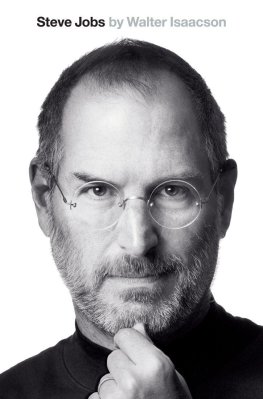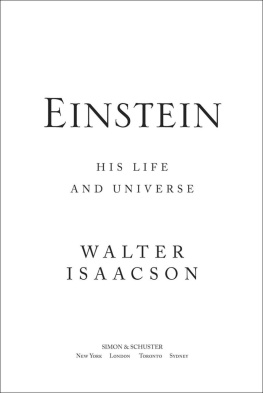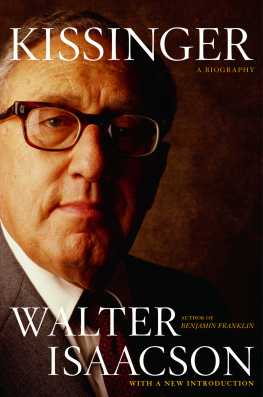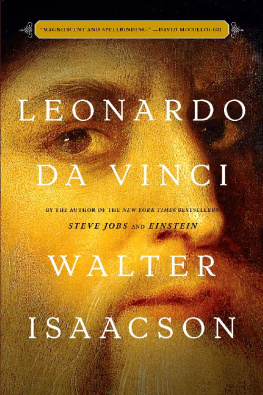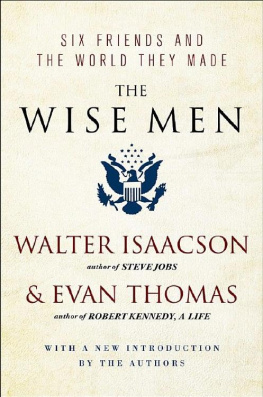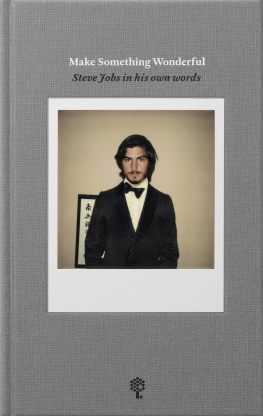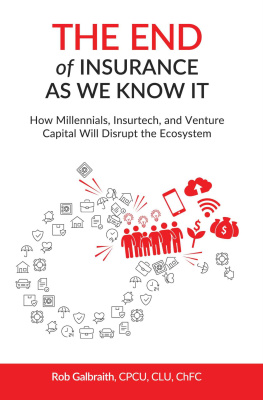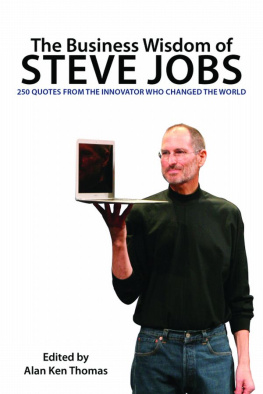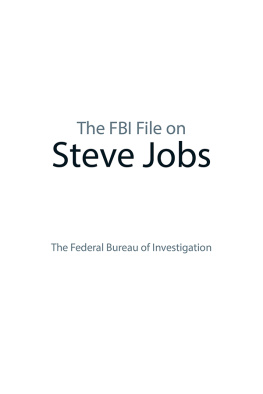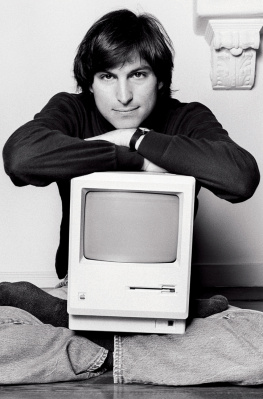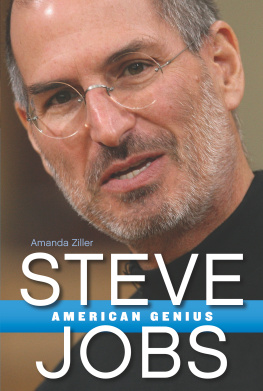Walter Isaacson
Steve Jobs: A Biography
The people who are crazy enough
to think they can change
the world are the ones who do.
Apples Think Different commercial, 1997

AL ALCORN. Chief engineer at Atari, who designed Pong and hired Jobs.
GIL AMELIO. Became CEO of Apple in 1996, bought NeXT, bringing Jobs back.
BILL ATKINSON. Early Apple employee, developed graphics for the Macintosh.
CHRISANN BRENNAN. Jobss girlfriend at Homestead High, mother of his daughter Lisa.
LISA BRENNAN-JOBS. Daughter of Jobs and Chrisann Brennan, born in 1978; became a writer in New York City.
NOLAN BUSHNELL. Founder of Atari and entrepreneurial role model for Jobs.
BILL CAMPBELL. Apple marketing chief during Jobss first stint at Apple and board member and confidant after Jobss return in 1997.
EDWIN CATMULL. A cofounder of Pixar and later a Disney executive.
KOBUN CHINO. A Soto Zen master in California who became Jobss spiritual teacher.
LEE CLOW. Advertising wizard who created Apples 1984 ad and worked with Jobs for three decades.
DEBORAH DEBI COLEMAN. Early Mac team manager who took over Apple manufacturing.
TIM COOK. Steady, calm, chief operating officer hired by Jobs in 1998; replaced Jobs as Apple CEO in August 2011.
EDDY CUE. Chief of Internet services at Apple, Jobss wingman in dealing with content companies.
ANDREA ANDY CUNNINGHAM. Publicist at Regis McKennas firm who handled Apple in the early Macintosh years.
MICHAEL EISNER. Hard-driving Disney CEO who made the Pixar deal, then clashed with Jobs.
LARRY ELLISON. CEO of Oracle and personal friend of Jobs.
TONY FADELL. Punky engineer brought to Apple in 2001 to develop the iPod.
SCOTT FORSTALL. Chief of Apples mobile device software.
ROBERT FRIEDLAND. Reed student, proprietor of an apple farm commune, and spiritual seeker who influenced Jobs, then went on to run a mining company.
JEAN-LOUIS GASSE. Apples manager in France, took over the Macintosh division when Jobs was ousted in 1985.
BILL GATES. The other computer wunderkind born in 1955.
ANDY HERTZFELD. Playful, friendly software engineer and Jobss pal on the original Mac team.
JOANNA HOFFMAN. Original Mac team member with the spirit to stand up to Jobs.
ELIZABETH HOLMES. Daniel Kottkes girlfriend at Reed and early Apple employee.
ROD HOLT. Chain-smoking Marxist hired by Jobs in 1976 to be the electrical engineer on the Apple II.
ROBERT IGER. Succeeded Eisner as Disney CEO in 2005.
JONATHAN JONY IVE. Chief designer at Apple, became Jobss partner and confidant.
ABDULFATTAH JOHN JANDALI. Syrian-born graduate student in Wisconsin who became biological father of Jobs and Mona Simpson, later a food and beverage manager at the Boomtown casino near Reno.
CLARA HAGOPIAN JOBS. Daughter of Armenian immigrants, married Paul Jobs in 1946; they adopted Steve soon after his birth in 1955.
ERIN JOBS. Middle child of Laurene Powell and Steve Jobs.
EVE JOBS. Youngest child of Laurene and Steve.
PATTY JOBS. Adopted by Paul and Clara Jobs two years after they adopted Steve.
PAUL REINHOLD JOBS. Wisconsin-born Coast Guard seaman who, with his wife, Clara, adopted Steve in 1955.
REED JOBS. Oldest child of Steve Jobs and Laurene Powell.
RON JOHNSON. Hired by Jobs in 2000 to develop Apples stores.
JEFFREY KATZENBERG. Head of Disney Studios, clashed with Eisner and resigned in 1994 to cofound DreamWorks SKG.
DANIEL KOTTKE. Jobss closest friend at Reed, fellow pilgrim to India, early Apple employee.
JOHN LASSETER. Cofounder and creative force at Pixar.
DANL LEWIN. Marketing exec with Jobs at Apple and then NeXT.
MIKE MARKKULA. First big Apple investor and chairman, a father figure to Jobs.
REGIS MCKENNA. Publicity whiz who guided Jobs early on and remained a trusted advisor.
MIKE MURRAY. Early Macintosh marketing director.
PAUL OTELLINI. CEO of Intel who helped switch the Macintosh to Intel chips but did not get the iPhone business.
LAURENE POWELL. Savvy and good-humored Penn graduate, went to Goldman Sachs and then Stanford Business School, married Steve Jobs in 1991.
GEORGE RILEY. Jobss Memphis-born friend and lawyer.
ARTHUR ROCK. Legendary tech investor, early Apple board member, Jobss father figure.
JONATHAN RUBY RUBINSTEIN. Worked with Jobs at NeXT, became chief hardware engineer at Apple in 1997.
MIKE SCOTT. Brought in by Markkula to be Apples president in 1977 to try to manage Jobs.
JOHN SCULLEY. Pepsi executive recruited by Jobs in 1983 to be Apples CEO, clashed with and ousted Jobs in 1985.
JOANNE SCHIEBLE JANDALI SIMPSON. Wisconsin-born biological mother of Steve Jobs, whom she put up for adoption, and Mona Simpson, whom she raised.
MONA SIMPSON. Biological full sister of Jobs; they discovered their relationship in 1986 and became close. She wrote novels loosely based on her mother Joanne (Anywhere but Here), Jobs and his daughter Lisa (A Regular Guy), and her father Abdulfattah Jandali (The Lost Father).
ALVY RAY SMITH. A cofounder of Pixar who clashed with Jobs.
BURRELL SMITH. Brilliant, troubled programmer on the original Mac team, afflicted with schizophrenia in the 1990s.
AVADIS AVIE TEVANIAN. Worked with Jobs and Rubinstein at NeXT, became chief software engineer at Apple in 1997.
JAMES VINCENT. A music-loving Brit, the younger partner with Lee Clow and Duncan Milner at the ad agency Apple hired.
RON WAYNE. Met Jobs at Atari, became first partner with Jobs and Wozniak at fledgling Apple, but unwisely decided to forgo his equity stake.
STEPHEN WOZNIAK. The star electronics geek at Homestead High; Jobs figured out how to package and market his amazing circuit boards and became his partner in founding Apple.
How This Book Came to Be
In the early summer of 2004, I got a phone call from Steve Jobs. He had been scattershot friendly to me over the years, with occasional bursts of intensity, especially when he was launching a new product that he wanted on the cover of Time or featured on CNN, places where Id worked. But now that I was no longer at either of those places, I hadnt heard from him much. We talked a bit about the Aspen Institute, which I had recently joined, and I invited him to speak at our summer campus in Colorado. Hed be happy to come, he said, but not to be onstage. He wanted instead to take a walk so that we could talk.
That seemed a bit odd. I didnt yet know that taking a long walk was his preferred way to have a serious conversation. It turned out that he wanted me to write a biography of him. I had recently published one on Benjamin Franklin and was writing one about Albert Einstein, and my initial reaction was to wonder, half jokingly, whether he saw himself as the natural successor in that sequence. Because I assumed that he was still in the middle of an oscillating career that had many more ups and downs left, I demurred. Not now, I said. Maybe in a decade or two, when you retire.

